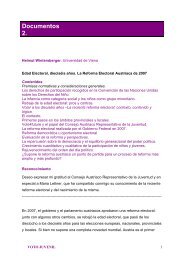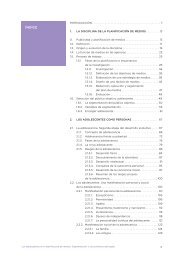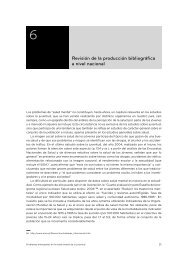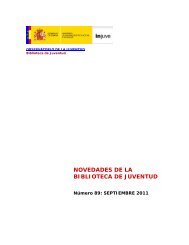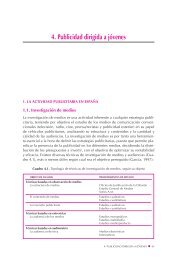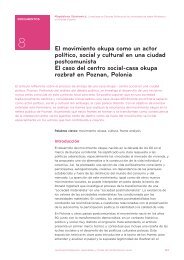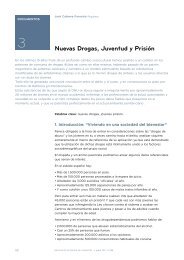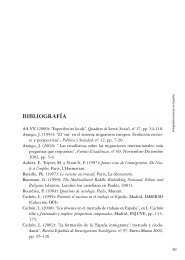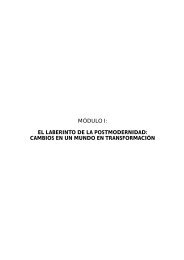9. Ofensores sexuales juveniles. José Díaz Morfa. Psiquiatra ... - Injuve
9. Ofensores sexuales juveniles. José Díaz Morfa. Psiquiatra ... - Injuve
9. Ofensores sexuales juveniles. José Díaz Morfa. Psiquiatra ... - Injuve
Create successful ePaper yourself
Turn your PDF publications into a flip-book with our unique Google optimized e-Paper software.
<strong>José</strong> <strong>Díaz</strong> <strong>Morfa</strong><br />
CONCLUSIONES<br />
Los hallazgos de la revisión de la literatura indican<br />
que los jóvenes que han cometido ofensas<br />
<strong>sexuales</strong> son un grupo heterogéneo que, como<br />
todos los jóvenes, tienen necesidades del<br />
desarrollo, pero que también tienen necesidades<br />
especiales y presentan riesgos especiales<br />
relacionados con sus conductas <strong>sexuales</strong><br />
abusivas. Los estudios existentes sugieren que<br />
una proporción sustancial de estos jóvenes<br />
desisten de cometer ofensas <strong>sexuales</strong> a<br />
continuación del descubrimiento inicial de la<br />
ofensa y la intervención terapéutica.<br />
La literatura claramente apoya la importancia de<br />
las intervenciones que son ajustadas al<br />
adolescente, individualmente. Las estrategias de<br />
manejo del riesgo que probablemente van a ser<br />
más efectivas son aquéllas que abordan las<br />
necesidades subyacentes a la conducta del joven y<br />
refuerzan la mayoría de las fuerzas existentes y<br />
apoyos positivos del joven. Aunque no se ha<br />
establecido la eficacia para muchas de las<br />
intervenciones en el ofensor sexual consideradas<br />
estandarizadas y requeridas, hay una amplia gama<br />
de intervenciones con más de una base empírica,<br />
particularmente dentro del campo de la<br />
delincuencia juvenil (tal como la terapia<br />
multisistémica), que puede ser efectiva. También<br />
se debería recordar que algunos jóvenes pueden<br />
requerir intervenciones mínimas una vez que su<br />
ofensa sexual ha sido descubierta.<br />
Finalmente, se debería recordar que aunque la<br />
meta cuando se trabaja con jóvenes que han<br />
cometido ofensas <strong>sexuales</strong> es ayudarles a detener<br />
sus conductas abusivas, lo primero es que son<br />
niños y adolescentes. Son personas jóvenes que<br />
han cometido ofensas y que merecen cuidado y<br />
atención y una autocomprensión de las causas<br />
subyacentes a sus conductas <strong>sexuales</strong> abusivas.<br />
BIBLIOGRAFÍA<br />
• Abel, G.G., Mittelman, M.S., and Becker, J.V. 1985. Sex<br />
offenders: Results of assessment and recommendations for<br />
treatment in clinical criminology. In The Assessment and<br />
Treatment of Criminal Behavior, edited by M.H. Ben-Aron, S.J.<br />
126<br />
Estudios de Juventud nº 62/03<br />
Hucker, and C.D. Webster. Toronto, Canada: M and M Graphic,<br />
pp. 191-205.<br />
• Abel, G.G., Osborn, C.A., and Twigg, D.A. 1993. Sexual assault<br />
through the life span: Adult offenders with juvenile histories. In<br />
The Juvenile Sex Offender, edited by H.E. Barbaree, W.L.<br />
Marshall, and S.M. Hudson. New York, NY: Guilford Press, pp.<br />
104-117.<br />
• Abel Screening, Inc. 1996. Abel Assessment for Sexual Interest:<br />
Juvenile Sex Offenders: Therapist Product Information. Brochure.<br />
Atlanta, GA: Abel Screening, Inc.<br />
• Araji, S. 1997. Sexually Aggressive Children: Coming To<br />
Understand Them. Thousand Oaks, CA: Sage Publications.<br />
• Association for the Treatment of Sexual Abusers. 1997a. Ethical<br />
Standards and Principles for the Management of Sexual<br />
Abusers. Beaverton, OR: Association for the Treatment of Sexual<br />
Abusers.<br />
• Association for the Treatment of Sexual Abusers. 1997b. Position<br />
on the Effective Legal Management of Juvenile Sexual Offenders.<br />
Beaverton, OR: Association for the Treatment of Sexual Abusers.<br />
• Avalon Associates. 1986. The Oregon Report on Juvenile Sex<br />
Offenders. Salem, OR: Children's Services Division, Department<br />
of Human Resources.<br />
• Awad, G.A., and Saunders, E. 1991. Male adolescent sexual<br />
assaulters, clinical observations. Journal of Interpersonal<br />
Violence 6(4):446-460.<br />
• Bagley, C., and Shewchuk-Dann, D. 1991. Characteristics of 60<br />
children and adolescents who have a history of sexual assault<br />
against others: Evidence from a controlled study. Journal of Child<br />
and Youth Care (Fall Special Issue):43-52.<br />
• Barbaree, H.E., and Cortoni, F.A. 1993. Treatment of the juvenile<br />
sex offender within the criminal justice and mental health<br />
systems. In The Juvenile Sex Offender, edited by H.E. Barbaree,<br />
W.L. Marshall, and S.M. Hudson. New York, NY: Guilford Press,<br />
pp. 243-263.<br />
• Becker, J.V. 1990. Treating adolescent sexual offenders.<br />
Professional Psychology: Research and Practice 21(5):<br />
362-365.<br />
• Becker, J.V., and Kaplan, M.S. 1993. Cognitive behavioral<br />
treatment of the juvenile sex offender. In The Juvenile Sex<br />
Offender, edited by H.E. Barbaree, W.L. Marshall, and S.M.<br />
Hudson. New York, NY: Guilford Press, pp. 264-277.<br />
• Becker, J.V.; Harris, C.D. y Sales, B.D. 1993. Juveniles who<br />
commit sexual offenses: A critical review of research. In Sexual<br />
Aggression. Issues in Etiology, Assessment, and Treatment,<br />
edited by G.C. Nagayama Hall, R. Hirschman, J.R. Graham and<br />
Maira S. Zaragoza, Washington, Taylor & Francis, pág. 215-228.<br />
• Becker, J.V. 1998. What we know about the characteristics and<br />
treatment of adolescents who have committed sexual offenses.<br />
Child Maltreatment 3(4):317-32<strong>9.</strong><br />
• Becker, J.V., and Hunter, J.A. 1997. Understanding and treating<br />
child and adolescent sexual offenders. In Advances in Clinical<br />
Child Psychology, vol. 19, edited by T.H. Ollendick and R.J.<br />
Prinz. New York, NY: Plenum Press, pp. 177-197.<br />
• Becker, J.V., Kaplan, M.S., Cunningham-Rathner, J., and<br />
Kavoussi, R. 1986. Characteristics of adolescent incest sexual<br />
perpetrators: Preliminary findings. Journal of Family Violence<br />
1(1):85-97.<br />
• Bengis, S. 1997. Comprehensive service delivery with a<br />
continuum of care. In Juvenile Sexual Offending: Causes,<br />
Consequences, and Correction, edited by G.D. Ryan and S.L.<br />
Lane. San Francisco, CA: Jossey-Bass Publishers, pp. 211-218.<br />
• Bonner, B. 1997. Child, adolescent, and adult sex offenders:<br />
Similarities and differences. Paper presented at the meeting of<br />
the Association for the Treatment of Sexual Abusers, Arlington,<br />
VA, October 1997.<br />
• Bonner, B., and Chaffin, M. 1998. Dyad and family therapy in<br />
sibling abuse and sibling sexual behavior. Workshop presented at<br />
the Conference on Responding to Child Maltreatment,<br />
American Professional Society on the Abuse of Children<br />
(APSAC) Advanced Training Institute, San Diego, CA, January<br />
1998.



